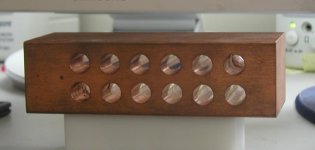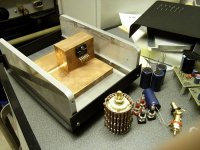Drilling in copper
Hi fellas, I was working on drilling holes in my copper heatsinks as well this evening so here is what I did for all you newbies out there. First I tried to use my 7.2V battery operated Ryobi drill with titanium metal bits and of course that didn't work. I ended up killing the bit and thank god my drill was okay .
.
So I went off to Lowes and purchased 1) 2 foot X 2 foot X 1/2 inch thick piece of birch plywood, 2) A set of protective goggles, 3) A wonderful kitset of bits that cost me only $15 for what looks like 50 or 60 bits for all uses, woodworking, metal, masonry, etc... 4) A Black & Decker 6A corded power drill and a pair of 99 cent clamps that fit supertight.
and a pair of 99 cent clamps that fit supertight.
So I clamped the copper pieces that I had (each about 1/2 inch thick!). Marked the hole with a hammer and nail so that my bit won't 'walk' all over the copper. Added a little bit of canola oil to the end of the bit and started drilling away with the copper clamped to the plywood. Even with a 6 amp drill, it took some work and I had to give the bit a break every now and then from overheating. At the end, my copper piece felt every so slightly warm
After going through two pieces of copper 1/2 inch thick each, my drill bit was worn, but hey, the kitset I bought had a ton more so...
Moral: Its not just important to be safe and careful...its just as important to spend some dough and buy the right tools. My Black & Decker cost me $29.95. If it were cordless it would be a heck of a lot more and since you don't need a cordless when you are diying amps you can get more for your money.
My 7.2V Ryobi has been relegated to drywall drills
Just an FYI,
Anand.
Hi fellas, I was working on drilling holes in my copper heatsinks as well this evening so here is what I did for all you newbies out there. First I tried to use my 7.2V battery operated Ryobi drill with titanium metal bits and of course that didn't work. I ended up killing the bit and thank god my drill was okay
 .
.So I went off to Lowes and purchased 1) 2 foot X 2 foot X 1/2 inch thick piece of birch plywood, 2) A set of protective goggles, 3) A wonderful kitset of bits that cost me only $15 for what looks like 50 or 60 bits for all uses, woodworking, metal, masonry, etc... 4) A Black & Decker 6A corded power drill
 and a pair of 99 cent clamps that fit supertight.
and a pair of 99 cent clamps that fit supertight.So I clamped the copper pieces that I had (each about 1/2 inch thick!). Marked the hole with a hammer and nail so that my bit won't 'walk' all over the copper. Added a little bit of canola oil to the end of the bit and started drilling away with the copper clamped to the plywood. Even with a 6 amp drill, it took some work and I had to give the bit a break every now and then from overheating. At the end, my copper piece felt every so slightly warm
After going through two pieces of copper 1/2 inch thick each, my drill bit was worn, but hey, the kitset I bought had a ton more so...
Moral: Its not just important to be safe and careful...its just as important to spend some dough and buy the right tools. My Black & Decker cost me $29.95. If it were cordless it would be a heck of a lot more and since you don't need a cordless when you are diying amps you can get more for your money.
My 7.2V Ryobi has been relegated to drywall drills
Just an FYI,
Anand.
The standard TPA(Tool Point Angle is 118Deg) on all drill bits, if you are able to grind it to 100Deg TPA on a bench grinder would be better for non-ferrous metals. USe light lubricant such as WD-40 or Varsol for best results, brass and copper tends to stick to the flutes of the drill bit.
The key here is to use Bench Drill Press adjusted for proper speed; drilling copper is not much problem then.
It took me less than half an hour to fabricate that 2" thick heatsink.
I usually use those drill bits (with aluminum): http://www.diyaudio.com/forums/showthread.php?postid=45896#post45896
It took me less than half an hour to fabricate that 2" thick heatsink.
I usually use those drill bits (with aluminum): http://www.diyaudio.com/forums/showthread.php?postid=45896#post45896
Attachments
Peter Daniel said:
Actually, at present, I'm using 100u BG N only, no other bigger caps. But this may not work well with all setups; easy to drive speakers, preferrably full range are rather recommended.
With regards to snubber, as some of you noticed, I got excited initially as well, as it dfinitely made a difference, and sound was more distinct and grabbing. Yet, my subsequent test show that everyhting was not right with a snubber, and ultimately, snubber is not an actual improvement.
As I designed the amp modules for those two way active speakers: http://soundfusion.ca/download/speakers.pdf , it was in my best interest to try improve on the original design and last weekend I took with me all popularly used capacitors as well as some snubbers and tried to prersent the new ideas to the makers of the speakers. The listening room was pretty well tuned and basically devoted to listening sessions only, with round wall behind the speakers and special damping panels all over. The source consisted of modified Shanling.
We were listening to various caps configurations and also snubber with big caps (I used very good 4 pole Jensens here). The snubber was rejected immediately. I could also clearly hear its inferiority. The sound was lacking air, top extention, bass became slow, lacking texture and snap.
We pretty much liked Panasonics, as they were quite musical and not boring. Interestingly, 1000u BG N were also rejected as sounding too mellow and tubey (those caps were pretty well broken in, as I was using them previously for half a year). Rubycons ZL had nice tight bass, but the tonal balance was shifted up and it didn't sound right.. Nichicons KZ were overall rather neutral, but lacking that special something that makes you want listening to the music.
According to the listeners in that session, 1000u BG STD were absolutely best choice: fast, detailed, extended, with proper tonality. To me, on more complicated passages the sound became a bit less organized with traces of harshness could be observed, but this didn't bother the other two guys.
We also tried 100u BG N by itself only. They didn't sound as good as in my system (but the speakers here were rather hard to drive, with 4 ohm impedance and 3rd order networks). They were distorting in bass a bit when pushed, and tonality was on a smoother side with sort of tubey character. For some it may be preferred choice but my two friends were into faster sounds and didn't like it that much. However, adding 1000u BG STD at the bridges (with 2' umbilical to the amp) fixed things substanially and it was pretty good combination (although they still claimed 1000u BG STD at the amp was better). It is not better to me, when I listen at home though ( and my speakers are very easy load).
So my current conclusion is that if BG STD 1000 seem harsh to you and you need more smoothness, add 100u BG N at the chip and use the other BG at the bridges.
If you need extra clarity and harmony with really delicate sound signature, no sign of harshness or brightness, you listen only at moderate levels on efficient and easy to drive speakers, and your material does not consist of Transe and House music (although it's still works for me) you might as well give a try to BG N 100u (only) and see how they perform. You can always add more capacitance later.
But the single, overall most universal choice, something I would use commercially, would be still 1000u BG STD (and no other caps).
Have you tried Elna Cerafines Peter?
I didn't try Cerafines, as suitable values were not available at that time. Tried them in a DAC and CDP power supplies though, and they always struck me as detailed and etched, kind of sterile sounding; may work well if system is overly warm.
Recently I came across an interesting post regarding snubbers, and was even tempted to use it as my signature http://www.diyaudio.com/forums/showthread.php?s=&postid=1141277#post1141277
http://www.diyaudio.com/forums/showthread.php?s=&postid=1141277#post1141277
Recently I came across an interesting post regarding snubbers, and was even tempted to use it as my signature
analog_sa said:Once i replaced my Lowthers with 'normal' speakers, the GC with 1000uF was no longer a pleasant amp. Followed CarlosFM suggestion for a high-cap snubbed PS and for a while forced myself to listen to it but any hint of magic was gone.
I did not try 1000uF FK in GC PS, but I was testing some FK caps in a DAC and I never liked them, they seemed too colored to me. BG N 1000uF is also not that good as amp bypass, it looks like bigger capacitance has different sonic signature than the smaller value of the same type. That's why for now, 100uF BG N is my favourite choice at the chip. You may experiment with capacaitance on rectifier's board though, maybe FKs would work here.
I had some older production BG F caps, but current STD was probably still better.
I had some older production BG F caps, but current STD was probably still better.
Destroyer OS. said:The DAC transformers... (ones from you for premium kit) What do they turn 115v into?
They turn it into 2 x 9V AC
dake13 said:Peter, any comments on a LM3875 amp in which one channel breaks up at moderate-to-moderately high volumes? I'm going to re-wire to the one channel, but I'm wondering if I toasted the chip (again).
It's hard to say, as it never happened to me. Maybe protection kicks in for some reason? What is the offset, does it run hot?Here's the link to wiring the kit: http://www.diyaudio.com/forums/showthread.php?postid=1108820#post1108820
So far this one was my favourite: http://www.diyaudio.com/forums/attachment.php?s=&postid=1123520&stamp=1170458051
I really need som help now. My head is all messed up at the moment.
My question is, can i wire like this?
My question is, can i wire like this?
An externally hosted image should be here but it was not working when we last tested it.
- Status
- This old topic is closed. If you want to reopen this topic, contact a moderator using the "Report Post" button.
- Home
- More Vendors...
- Audio Sector
- AudioSector-chip amp kits, dacs, chassis


